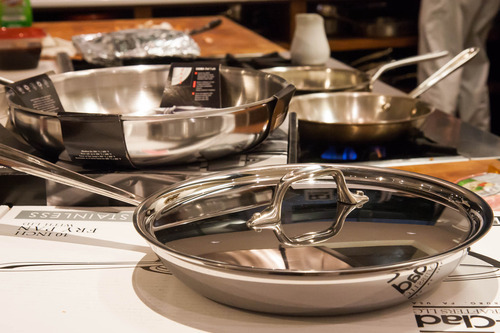
The ten-inch frying pan is a kitchen cornerstone. Whether you’re searing meats, sautéing veggies or making a sauce, it’s an easy and dependable utensil, especially if you’ve invested in quality. But what makes a great pan great? Why go from better to best? Read on as Shaw TV “Island Chef” Michael Williams and I test out a couple of Cook Culture’s most popular brands to find out which comes out on top.
All-Clad has been one of Cook Culture’s core brands for a long time, and their made-in-the-USA d5 collection is the top of the heap with its five layer construction and stainless steel core. That core helps prevent the warping you sometimes see on older All-Clads and enhances the conductivity of the aluminum inner layers for faster, more even heating. The d5 series is also induction-optimized, making it ideal for the new generation of highly-efficient, super quick stovetops.
However, the growing popularity of induction ranges has inspired other manufacturers to enter the market, not least of which is Zwilling J.A. Henckels. After their purchase of Belgian cookware pros Demeyere in 2008, Zwilling developed a new line of affordable pots and pans based on Demeyrere’s cutting-edge metallurgy. This new “Sensation” collection fits neatly between the great value of All-Clad and the high-end Demeyere products, making it a new favourite here at Cook Culture. Both of these brands have seen plenty of use in the Cook Culture test kitchen, but never head-to-head, so we were eager to find out if the Sensation pan held up to its higher price tag.
Before turning on the burners, Chef Michael picked up a pan in each hand and tested their heft. “A good frying pan, or pot for that matter, has to have weight to it,” he said. “If it doesn’t, that means it’s really thin gauge metal, the heat is not going to distribute evenly and you’re going to be much more likely to burn your food. Someone might think they’re a shitty cook, but they’ve just got shitty pots and pans and that’s why they’re always failing.” That definitely helps explain a lot of my own kitchen nightmares — or at least, it’s a handy excuse.

Next, Michael demonstrated his “chef flip”. One of the big selling points for the Sensation pans is their shot-blasted handles; the finish provides better grip, and the join is welded on instead of riveted for easier cleaning. “The handle has to be comfortable for sure,” said Mike. “This is a little bit sleeker, more stylish, it has a nice feel to it when you pick it up. It feels slightly heavier than the All-Clad, a little more weight to it, maybe a slightly heavier gauge. First impressions are the Henckels is a little bit higher quality.”
For our first test, Michael quickly cut up an onion. “I just want to see how it cooks and caramelizes, see if there’s any sticking going on, if I can do it with relatively little oil without it starting to burn and stick.” The trick to stick-free stainless steel cooking is to pre-heat your pans on low or medium heat, then add the cooking oil and allow it to warm up before adding any ingredients. This way you get a non-stick surface without the chemicals and short half-life of Teflon or other typical non-stick pan.

In went the onions. After only a half a minute or so, it was already clear to see some of the pieces in the All-Clad stay in one spot. “This one is starting to stick already as the oil is being absorbed into the onions, whereas this one isn’t quite as bad,” he said. “Even though that oil is gone it’s still moving around, whereas in this one it’s starting to burn. First test goes to Henckels hands down.”
One of the best parts about stainless cookware is how easy they are to clean after use. After clearing out the onions we put both pans in the sink, and a little splash of water had already cut channels in the char on the Sensation. “That’s a good sign, it’s leading me to believe that one will be pretty easy to clean.” After some scrubbing and a round with steel wool, the All-Clad was back to its shiny finish. In contrast, the Sensation pan needed only a splash of water before all the browning lifted right off. Part of the Sensation package is the electro-chemical Silvinox treatment, originally created for the Demeyere cookware. The Silvinox process removes iron atoms from the top layer to produce a smoother, higher finish, and in this test its effectiveness was clear.
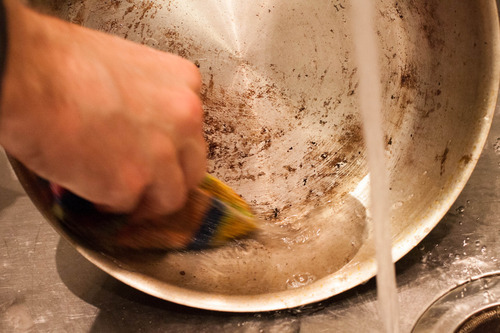

Next, we tried a basic breakfast, starting with a simple egg over hard. Mike laughed. “I can’t help seasoning them!”
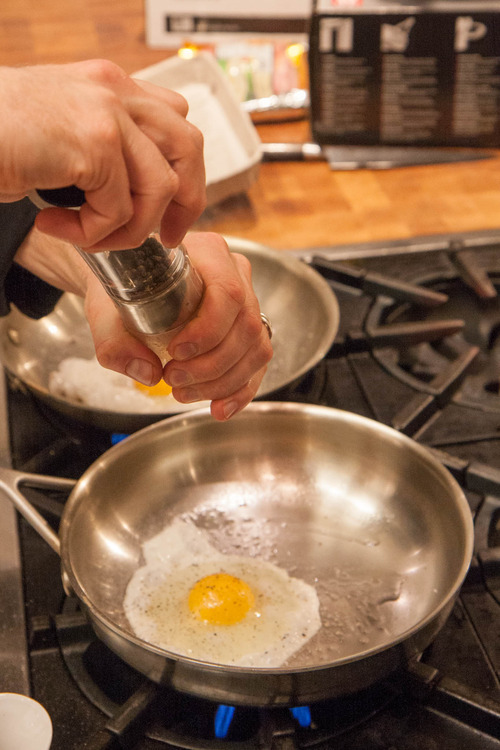
Surprisingly, the All-Clad let go of the egg completely, allowing Michael to make a perfect flip, while the Sensation’s egg fell apart. “That came up real nice, but this one actually stuck more!”
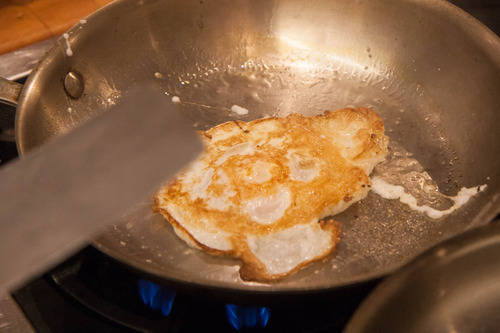

Something seemed a little off, but we moved on to trying a few strips of lean bacon with no oil. On both pans the bacon left a healthy char, though there was slightly more crust left on the Sensation pan. “Pretty much the same, very close,” said Mike. “The no oil, lean bacon test, slightly to the All-Clad.”
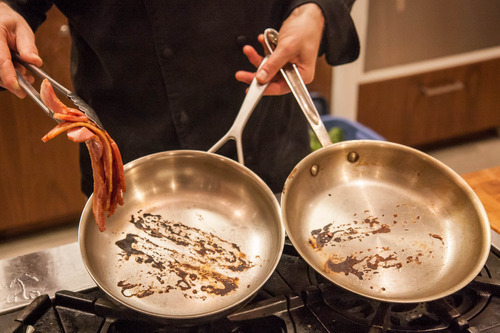
Though Chef Michael was pressed for time prepping for his Winter Salads and Braised Meats class, he couldn’t resist running the egg test again. For a second time, the Sensation egg fell apart, while the All-Clad’s stayed easily flippable. Mike’s brow furrowed. He wiped out the pans, turned up the heat slightly on the Sensation and waited a few extra seconds before cracking a final egg into each.
This time, the Sensation performed as expected, keeping the delicate egg white unstuck from the stainless surface and allowing Mike to make a neat over-hard. So keep that in mind: the higher end pans may need a little more preheating thanks to their thicker, more consistently heating construction. You can always check your pans temperature before adding oil by flicking a bit of water on it; the water should bead and run around before evaporating, otherwise it maybe be too hot or cold.
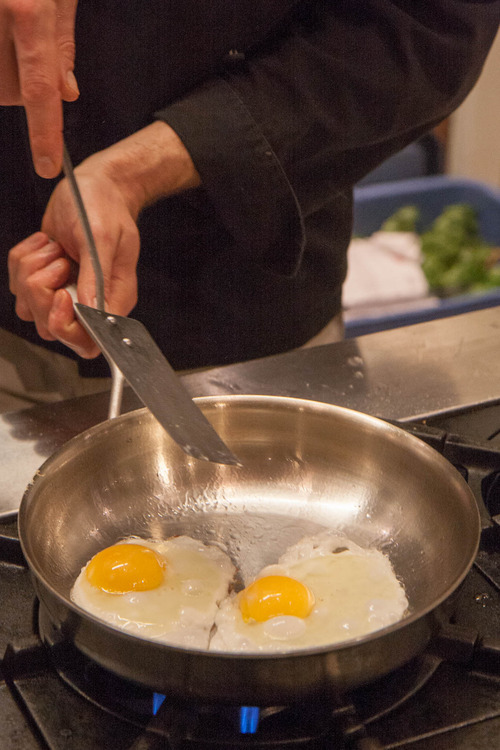
After watching all three tests, Mike’s final thoughts echoed my own. “I do prefer the Sensation for sautéing, it had a nicer feel to it,” he said. “The way it caramelized the onions, there was less scorching and a little more even heat distribution. Just gauging by how the onions performed, it’s going be the same with anything you’re cooking for a longer time, you’ll have more consistent cooking with this, and so this hands down is worth the extra money now that we’ve solved that one little problem with the eggs. Isn’t that funny, this one thing almost changed the whole perspective!” - Sol

